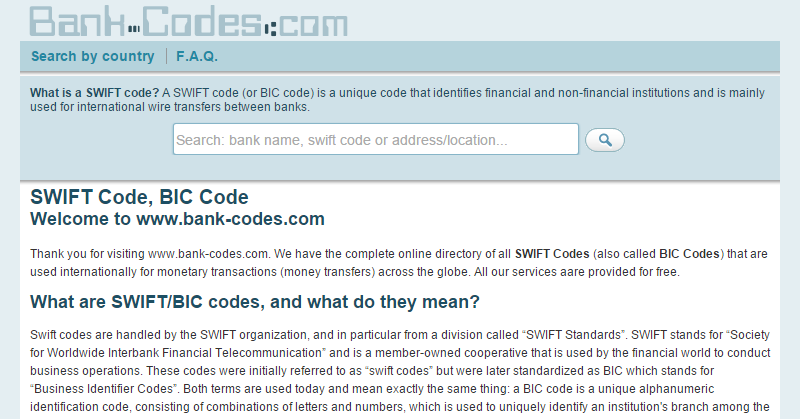Swift Code (BIC) – ZFBAZML1 02N
In this page you will find detailed information about the swift code “ZFBAZML102N” of “Finance Bank Zambia Limited.”.
What is a SWIFT code?
SWIFT codes are used to identify banks and financial institutions worldwide. They are used by the swift network to transmit wire transfers (money transactions) and messages between them. For international wire transfers, swift codes are always required in order to make transactions secure and fast.
These codes were initially introduced by the SWIFT organization as “swift codes” but were later standardized by the International Organization for Standardization (ISO) as “BIC” meaning “Business Identifier Codes”. Most people think B.I.C. stands for “Bank Identifier Codes” (“bank” instead of “business”) but that is incorrect since non-financial institutions can also join the swift network.
A “BIC code” can be seen by many different names, like “SWIFT code” (most common), “SWIFT ID”, “SWIFT-BIC”, “SWIFT address”, “BEI” (that comes from “Business Entity Identifier”), or even “ISO 9362”, which is the standard format that has been approved by the ISO organization. The acronym SWIFT stands for the Society for Worldwide Interbank Financial Telecommunication.
In depth analysis of a swift code
Swift codes are broken down into sections, in the same way telephone numbers are broken into sections, and every section reveals some information about the institution that was assigned this code. They consist of eight or eleven characters. Whenever an eight-character code is used, then it is referring to the headquarters (main office) of the institution.Here is how an 11-character code is broken down and what each section of characters represents. Let’s take this imaginary 11-character swift code:
AAAABBCCDDD
It can be broken down to these sections:
AAAA – BB – CC – DDD
Section 1 (the first 4-characters “AAAA”): This code is used to identify the institution’s global presence (all branches and all divisions around the world). For example, “CHAS” is used for “JPMORGAN CHASE BANK”
Section 2 (5th and 6th characters “BB”): This two-letter code represents the country of this particular institution’s branch and follows the ISO 3166-1 alpha-2 standard for representing country codes. For example, “US” for “UNITED STATES”, “GB” for “UNITED KINGDOM”, CA for “CANADA”, etc.
Section 3 (7th and 8th characters “CC”): These characters represent a location code (e.g. “FF” is the code for “Frankfurt”, “KK” is the code for Copenhagen, etc.) and also the second character (8th in the B.I.C.) sometimes carries this information:
- If it is equal to “0”, then it typically is a BIC assigned for testing purposes (as opposed to a BIC used on the live network).
- If it is equal to “1”, then it denotes a passive participant in the SWIFT network.
- If it is equal to “2”, then it typically denotes a “reverse billing” BIC, meaning that the recipient of the message has to pay for the message.
Section 4 (9th to 11th characters “DDD”): These final three characters form a “branch code” that refers to the particular branch of the institution. If this section is omitted, then we have an 8-character swift code that is assumed to refer to the HEAD OFFICE of the institution. Also, a typical naming convention is that in the case we are referring to the main offices of an institution, this branch code is “XXX”.
Some popular swift code searches:
Try our online SWIFT/BIC lookup tool to locate any of the thousands active or passive swift codes. Our primary focus is to provide you with the most accurate and up to date database of financial institutions all over the world. You can search for an institution’s detailed data by entity name, BIC, or even specific keywords that narrow the search results even more. You can also browse for swift codes by clicking on the list of countries and then choosing the institution’s name from the alphabetical list.
We are certain that this site will help you save a lot of time (hence… money!), especially if you are dealing with lots of bank transactions daily. Please read our disclaimer at the bottom of this page before using our online tool.



